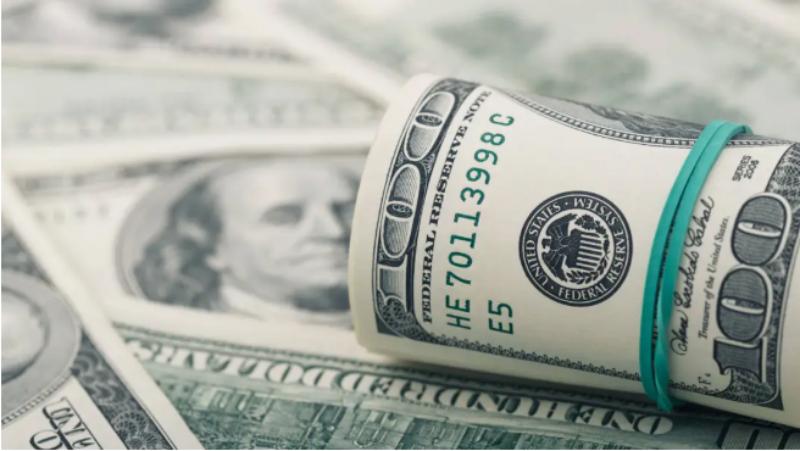RMB is strong and the dollar index is broken!
The tariff war continues to escalate, the dollar index did not strengthen as expected, but by the poor economic outlook dragged down to near 105, the market is expected to the Federal Reserve will cut interest rates 3 times this year, much higher than expected at the beginning of the year.
In contrast, the yuan, which was previously tipped to depreciate sharply, has held up exceptionally well, rallying more than 500 points this week. on March 6, the offshore yuan rose 193 basis points to 7.2357 against the dollar.
Last week, the US Dollar Index fell below the 107 mark, broke below the 106 round figure overnight, and broke below the key 120-day SMA. in the evening of March 5, the US Dollar Index fell below the 105 mark.
The original logic lies in the fact that Trump, if he announces a new plan to impose tariffs, may strengthen risk aversion and drive the dollar higher, while tariffs triggered by the U.S. inflation concerns will make it difficult for the Federal Reserve to cut interest rates, further driving the dollar and U.S. bond yields higher. But all walks of life began to worry more and more about the slowdown in the U.S. economy, consumer confidence in the tariff wars continued to sink, overlaid with a pickup in inflation, which will aggravate stagflation concerns.
Recent data on economic activity in the U.S. has been weaker than expected, with the PCE report released on Friday showing a decline in consumer spending in January, the U.S. trade deficit widening sharply over the past few months, and first-time jobless claims rising significantly last week. Accordingly, the Atlanta Fed's GDPNow model cut its forecast for annualized GDP growth in the first quarter by more than 4 percentage points to -1.5%.
Despite the short-term weakness of the dollar, some institutions still express the need for caution and expect the dollar to remain supported, especially if risk aversion spreads in markets other than the dollar.

One of the reasons for this is that the market still needs to confirm whether the US economic data is really that weak. Goldman Sachs chief U.S. economist Jan Hatzius said that although U.S. GDP growth is expected to slow this year and policy uncertainty poses further downside risks, the latest data is not as bad as it seems. First, the widening trade deficit since last November largely reflects higher gold imports, which are not counted in GDP as they are not typically used for consumption or production, and second, the weakness in consumer spending in January may have been driven by a combination of cold weather, residual seasonal effects, and a return to normalization from the unusually strong momentum in the second half of 2024. Goldman Sachs thinks the reading of the latest data is overdone. The agency is tracking a +1.6% annualized GDP growth rate for the first quarter, slightly below its initial forecast but well above the Atlanta Fed's estimate. This has led Goldman Sachs to lower its forecast for year-over-year GDP growth in the fourth quarter of 2025 to 2.2% from its initial 2.4% forecast.
Another reason is that the strength of the euro can be sustained. The euro has been riding high recently, rising to 1.07 intraday, which is the main cause of the dollar index down below 105, and the euro against the yuan rose to 7.7. Liu Yang said that the new German government's fiscal expansion, treasury yields a pillar of support for the euro in the medium and long term strength. In addition, the Russia-Ukraine truce is expected to support the euro higher.
Standard Chartered Global Chief Strategist Robertson said that even assuming increased defense spending in European countries, Russia and Ukraine may cease fire on the eurozone growth prospects are not conclusively good news, and more importantly, perhaps, the possibility of implementing a large-scale fiscal stimulus. Once the market realized that the euro zone fiscal impulse may be disappointing, the market is expected to focus on the focus will once again turn to the European Central Bank, the latter may need to further relax monetary policy, so as to shoulder the burden of stabilizing euro zone growth, the euro or also under pressure.

On March 5, the yuan strengthened slightly against the U.S. dollar, with the offshore yuan surging more than 500 pips this week, unaffected by the tariffs. The dollar's exchange rate against the offshore yuan has now risen back to the middle of the fluctuation range since the beginning of the year, following a dip below 7.25 in mid-February.On March 6, the offshore yuan was up 193 basis points at 7.2357 against the dollar.
“We expect the dollar/offshore yuan exchange rate to remain in the 7.20 to 7.35 range.” Robertson said.
Clear stabilization signals from China's central bank have continued to support the yuan so far this year, with traders saying the mid-price usually acts as a counter-cyclical adjustment as tariffs heat up. In addition, a large number of offshore yuan central bank bills issued at the beginning of the year are also sending signals.
Liu Yang, a foreign exchange expert and general manager of the financial market business department of Zheshang Zhongtuo Group, said that on several days in late February, the US dollar index weakened, and so did the RMB mid-price, but on February 28, the US index rebounded, and the RMB mid-price was instead strengthened under the tariff perturbation, and the central bank clearly conveyed the signal of stabilizing the exchange rate. In the short term, the additional 10% tariffs may not cause the yuan to fall below the 7.35 mark, especially against the backdrop of dollar pressure.
On March 5, the 2025 government work report proposed a GDP growth target of around 5% in 2025 and a more robust CPI target; the proposed issuance of 1.3 trillion yuan of ultra-long-term special treasury bonds and 500 billion yuan of special treasury bonds to replenish the capitalization of large banks. the 2025 deficit rate is proposed to be arranged at around 4%, with a deficit size of 5.66 trillion yuan, and special bonds for local governments of 4.4 trillion yuan. All budgets are expanded from last year.
Our company has developed a lot of home storage products, including storage baskets, kitchen shelves, bathroom shelves, etc. Welcome to inquire about purchasing, we are willing to give price concessions to make up for the difference in tariffs and exchange rates.

Our company has developed a lot of home storage products, including storage baskets, kitchen storage rack, bathroom storage rack and so on, there is always a suitable one for you, welcome to inquire and purchase, we are willing to give price concessions to make up for the difference in tariffs and exchange rates.
